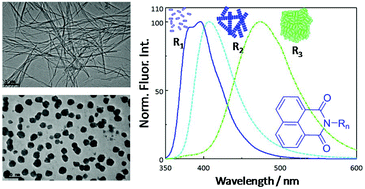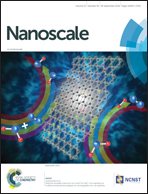Insights into the aggregation-induced emission of 1,8-naphthalimide-based supramolecular hydrogels†
Abstract
The study of aggregation-induced emission (AIE) of a series of 1,8-naphthalimide derivatives in aqueous media is reported herein. Some of these molecules constitute the first examples of 1,8-naphthalimide-containing amino acid derivatives that form hydrogels with excellent photophysical and mechanical properties. The present study provides further insights for the rational design of water-compatible stimuli-responsive photonic materials presenting AIE. AIE was quantitatively evaluated by measuring the fluorescence quantum yields of the molecules. Gelators 1 and 2 exhibit self-assembled fibrillar morphologies and present the best performance regarding the AIE effect, showing a remarkable enhancement in fluorescence intensity of 4700% and reaching a notable fluorescence quantum yield (Φf) of 30%. Non-gelator molecules 6 and 7 form nanoparticles, which also present AIE, but with emissions corresponding to their excimers. Therefore, the AIE intensity and wavelength are regulated by the type of aggregate morphology: fibers, nanoparticles or soluble species.



 Please wait while we load your content...
Please wait while we load your content...